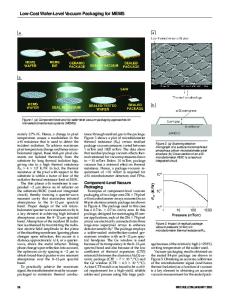Optical Interconnect Components for Wafer Level Heterogeneous Hyper-Integration
- PDF / 478,956 Bytes
- 5 Pages / 612 x 792 pts (letter) Page_size
- 86 Downloads / 335 Views
F6.11.1
Optical Interconnect Components for Wafer Level Heterogeneous Hyper-Integration
P. D. Persans, M. Ojha, R. J. Gutmann, J.-Q. Lu, A. Filin, J. Plawsky Focus Research Center: Interconnections for Gigascale Integration Rensselaer Polytechnic Institute, Troy, New York 12180, U.S.A
ABSTRACT Optical waveguides for three-dimensionally stacked chip fabrication technologies, in which optical connection between layers plays a central role, are described. CMOS-compatible approaches to optical via and waveguide fabrication are addressed. Detailed modeling is used for design optimization and also addresses how manufacturing variations from ideal design may affect device performance. INTRODUCTION Three-dimensional integration in which wafers are stacked is an attractive technology because it decreases RC delays by allowing shorter electrical wire lengths [1, 2]. This is particularly important as feature size reduction results in interconnect delays that limit advances in highspeed digital ICs at future technology nodes. Stacking wafers also enables hyper-integration in which devices of different functionality and structure can be included in CMOS-compatible ways [3]. Future computer chips may also require novel components that may include quantum spin state, quantum dot, magnetic, and/or magneto-optic components, some of which may be based on molecular-scale structures. It is likely that these components will be integrated with CMOS-like drivers and with significant portions of the chip based on CMOS manufacturing technologies. Connection to, or reading of, some of these components will be facilitated by direct optical interaction. Integrating optics onto the chip will also facilitate high-speed communication off the chip. In this paper we describe example structures where optical beams are coupled vertically from a horizontal waveguide layer through stacked CMOS wafer layers to an active device layer as shown schematically in Fig. 1. We have previously described the fabrication and characterization of forty-five degree self-aligned aluminum mirrors on 2-micron polymer waveguides [4, 5]. The remaining problem is to couple this beam into a device in the lowest level of the structure. In the first case, the light is coupled vertically into a waveguide via. In the second, the vertical beam passes directly though the multilayer stack to a device in the lowest CMOS layer. We have modeled the optical behavior of these structures using BeamProp (TM), and FullWave (TM) software, as well as basic plane-wave calculations. Many issues must be addressed in the design such structures. Optical considerations include: What is the transmission of the structure? What operating wavelengths are available or recommended? Is the transmission of the structure sensitive to wavelength? What are the limitations on beam size and angular range? Fabrication and processing considerations include: How does the available choice of materials affect optical functionality (i.e.- absorption and index)? Are thermal and chemical properties compatible? Are
Data Loading...









